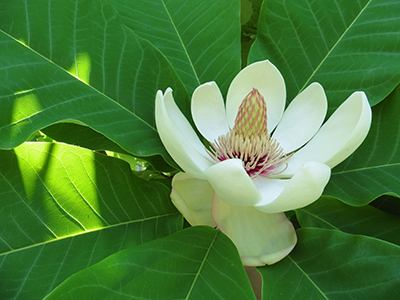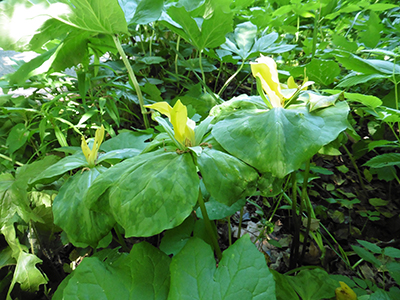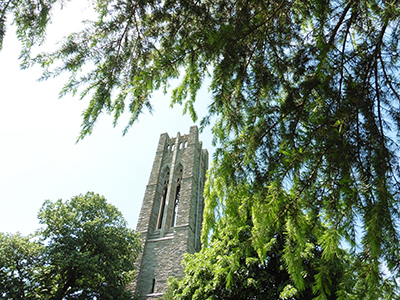
Plant of the Week: May 21
By Rachael Martin, 2018 Summer Intern

Magnolia obovata
As we ease out of spring into summer, the stunning display of our deciduous magnolias is beginning taking hold. One in particular is Magnolia obovata, commonly thought of as the Japanese relative to our native big leaf magnolia (M. macrophylla). Similar to our native species, M. obovata also has broad, deciduous leaves, but as the specific epithet would suggest, they are rounded at the terminal end in an egg-like shape. This was a brand new Magnoliaceae family introduction for me, and one that I might have missed had it not been for the sweet fragrance of its blooms. Along with its fragrance, the milky white tepals of M. obovata unfold to reveal maroon tepals making for a lovely contrast. A specimen can found at the corner of the Dwell Hall planting.
Photo credit: R. Martin

Trillium luteum
A true staple of spring could be represented by none other than the flowering of the trilliums, specifically the native Trillium luteum. Like with most trillium species, T. luteum blooms in April and is just now finishing its blooming season. As the botanical name suggests, this particular trillium species is an eye-catcher with bright yellow petals. The flowers give off a distinct lemon scent which is one of T. luteum’s shining characteristics. The native range of this particular trillium is found in the Southeastern states of Georgia, North Carolina, and Kentucky. However, you don’t need to travel far to view (and smell) this lovely woodland wildflower! It can be found in the Meetinghouse Woods, along with other shade-loving herbaceous perennials.
Photo credit: R. Martin

Cedrus deodara ‘Roman’s Gold’
Cedrus deodara ‘Roman’s Gold’ is one of many evergreen conifers in the Pinetum. The cultivar ‘Roman’s Gold’ delivers bright warm new growth compared to the more grey and blue hues of the straight species. Taking on a pyramidal growth habit, ‘Roman’s Gold’ begins to round off its crown with age and can reach heights of up to 60 feet.
Photo credit: R. Martin





John Schucker
Posted at 11:28h, 21 JuneHello. I ;always enjoy reading about what is going on at the amazing Scott Arboretum. However, it seems this last blog should have had some proofreading before being published. Here are some suggested improvements.
The stunning display of our deciduous magnolias IS beginning…(the verb should agree with display, not magnolias)
Along with ITS fragrance…(the use of the possessive is correct in other places)
…at the corner of THE Dwell Hall planting. (sounds more natural)
…the trilliums, specifically[,} the native… (the 2nd comma in brackets is not necessary)
…this particular trillium species is AN eyecatcher… (obviously an oversight)
…bright yellow[,] petals. (the comma after yellow should be removed)
…is one of many [ is an ] evergreen conifers… (clearly the writer changed her mind but neglecting to delete the bracketed words)
I don’t expect my comments to be published. I simply want to help and suggest someone take an opportunity to make some corrections.
Thank you.
John Schucker… a frequent reader
John Schucker
Posted at 11:32h, 21 JuneHah! I need to take my own advice! The font color and size in this box for typing comments is not so easy to read. Anyway, that’s my excuse!
JS